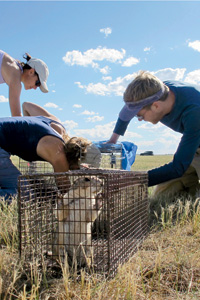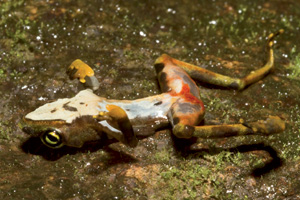by Heidi Ridgley and James Navarro
Relocation Redux

© Lacy Gray / Defenders of Wildlife
Highly social and dependent on one another, prairie dogs share a lot of muzzle time—chattering, grooming and doing what even looks like kissing and hugging. But things are not so rosy for these rotund rodents, which have declined by more than 95 percent across the Great Plains.
Considered pests because they eat grass that ranchers would rather feed their livestock, prairie dogs are shot and poisoned even on public lands. Without them, the highly endangered black-footed ferret—which dines on the dogs almost exclusively—hasn’t a hope. Many other species use their burrows as homes.
That’s why, for the second year in a row, Defenders and our conservation partners stepped up to help save hundreds of prairie dogs at the edge of Thunder Basin National Grassland in eastern Wyoming. Rather than see them poisoned or shot, Defenders’ Montana field office helped relocate them to a fully protected spot in the middle of the basin. Here, the U.S. Forest Service’s goal is to restore 18,000 acres of prairie dog colonies for the benefit of all the wildlife that depend on them.
“That may sound like a lot of land, but it’s less than 4 percent of the 550,000 acres that make up Thunder Basin,” says Jonathan Proctor, Defenders’ prairie expert. “The project is setting a new standard for managing this keystone species. We hope this will become a model for nonlethal management at all nine national grasslands.”
Proof positive that you can teach an old dog new tricks.

© Brian Gratwicke
Fast and Furious Fungus
Scientists confirmed this summer that chytrid fungus, a deadly and rapidly spreading amphibian disease, has reached Panama’s Darien region, one of Central America’s largest remaining wilderness areas and its last fungus-free region. This is troubling news for the Panama Amphibian Rescue and Conservation Project, a consortium of zoos, government agencies, research organizations and conservation groups, including Defenders, that is trying to build a Noah’s Ark for the 20 species of frogs in the most imminent danger of extinction. Captured animals are kept at a breeding center until a cure for the disease is found.
First observed in Australia and Central America in the 1980s and 1990s, the highly contagious disease is at least partially responsible—along with habitat loss, climate change and pollution—for the loss of 94 of the 120 frog species thought to have gone extinct since 1980.
Within five months of arriving in western Panama, chytrid wiped out half of the frog species. “The unrelenting and extremely fast-paced spread of this fungus is alarming,” says Doug Woodhams, a researcher with the Smithsonian Tropical Research Institute.
The mountainous regions of eastern Panama are one of the last remaining strongholds of native amphibian populations in the New World.
To Spot an Ocelot

© Tony Battiste / Portraits in Nature
This elusive feline has wildlife officials in Arizona doing a double take. That’s because until this ocelot photo was snapped by the Arizona Game and Fish Department in February—and a camera trap caught what may be the same cat again in July—there had been only four sightings in the Grand Canyon State since 2009. The only U.S. breeding population of ocelots exists in southern Texas, even though the rare cat once roamed across the Southwest. Habitat loss, the fur and pet trades, and more recent threats like climate change and the U.S.-Mexico border wall have all taken a heavy toll on the North American population. Still, the sightings suggest that there may just be enough habitat left in Arizona for these wandering wildcats to put down roots.
Learn more about frogs around the world.
Only select articles from Defenders are available online. To receive 4 issues annually of the full award-winning magazine, become a member of Defenders of Wildlife!



